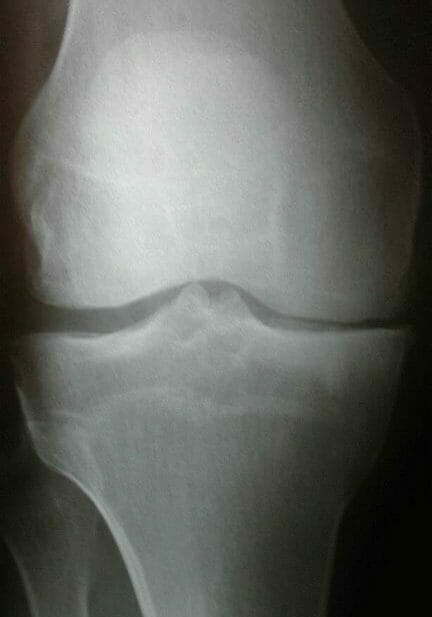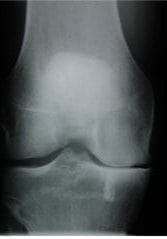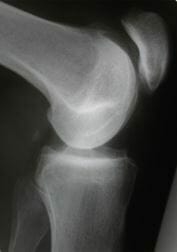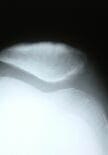What is The purpose of knee radiographs?
The purpose of knee radiographs is to assess the bony structure of the knee and specifically to define the presence of fractures and also to assess for degenerative disease within the joint.
Many different types of plain x-rays can be taken, but all investigations should have a purpose and should answer specific questions. The knee is a weight bearing joint and therefore for all intents and purposes, knee x-rays should be taken while weight bearing. As radiographs are a two-dimensional representation of a three-dimensional bony structure, radiographs are normally taken in two planes at right angles to each other to infer all three dimensions. I tend to use a specialized series of knee radiographs to emphasise certain aspects of the knee joint.
My Routine Knee Joint Series Include:
These views all emphasise different aspects of the knee joint.

An AP standing x-ray of the knee showing some medial (inner) joint space narrowing.

A 45 degree flexed PA weight bearing X-ray of the knee showing complete loss of medial (inner) joint space which was not evident on the standing AP X-ray

A 60° true lateral X-ray of the knee showing a patella alta (high riding patella due to a long patella tendon. Also seen is some trochlea (groove of femur) dysplasia (abnormal shape).

A 30° merchant’s X-ray of the knee
The standing AP x-ray will give an indication of the presence of degenerative disease within the knee and also an indication of the alignment of the knee joint.
The 45° flexed PA standing view of the knee is a much more sensitive x-ray showing early degenerative disease in the position of function. This view also allows accurate definition of the width of the intercondylar notch. This is very useful information for patients undergoing ACL reconstruction. The width of the intercondylar notch gives and indication of the size of the contents of the notch which are the anterior and posterior cruciate ligaments. 60% of the notch is occupied by the PCL, 40% by the ACL approximately. It has been shown by Shelbourne and co-workers, that patient with a narrow notch are more likely to tear their ACL’s as this is an indication of a small anterior cruciate ligament. Measuring the size of the notch on the x-ray allows me to plan the degree of notchplasty that is required. In certain situations, it can also help me to decide whether to use an ipsilateral or contralateral patella tendon graft for the ACL reconstruction. We do not walk with our knees fully extended, but tend to have our knees flexed during the gait cycle and so a flexed x-ray view will bring the weight bearing part of the knee joint into the view on the radiograph.
The true lateral will show the patello femoral joint and gives a good measure of patella tendon length which can be abnormal in certain conditions such as recurrent patella dislocation. It will also show the depth of the trochlea groove in which the patella articulates and once again, which can be abnormal in conditions such as recurrent patella dislocation. The true lateral is the only view that will accurately show the depth of the trochlea groove.
The Merchant’s view shows a skyline projection of the patella articulating with the trochlea and will show any static malalignment or maltracking, such as can be illustrated with patella tilt and patella subluxation, which can occur in recurrent patella dislocation or anterior knee pain syndromes.
The AP and lateral views will also reveal evidence of osteochondral injuries and osteochondritis dissecans.
All these views will also show fractures about the knee and may give information to direct further imaging studies.
Standing Long Leg Alignment Views
In patients who will be having total or partial knee replacements, or who are candidates for osteotomies, it is important to measure the alignment of the lower limb. Once again, this should ideally be done in a weight bearing position and the best method that we currently have available for doing this is a standing long leg alignment film, which shows the hip, knee and ankle on one x-ray film, on which lines can be drawn to measure various angles around the knee including the anatomical and mechanical axis of the lower limb. This information is then used to correct any deformity in the knee at the time of joint replacement or osteotomy.
This is a view that I routinely use for all my joint replacements and osteotomies to allow accurate correction of the underlying deformity at the time of surgery.
A long leg standing X-ray. The red line represents the body’s line of weight-bearing (mechanical axis) through the knee. The axis runs from the centre of the hip to the centre of the ankle and should pass just through the medial (inner) compartment of the knee.
Make An Enquiry
Or contact us directly
[email protected]
0161 445 4988
